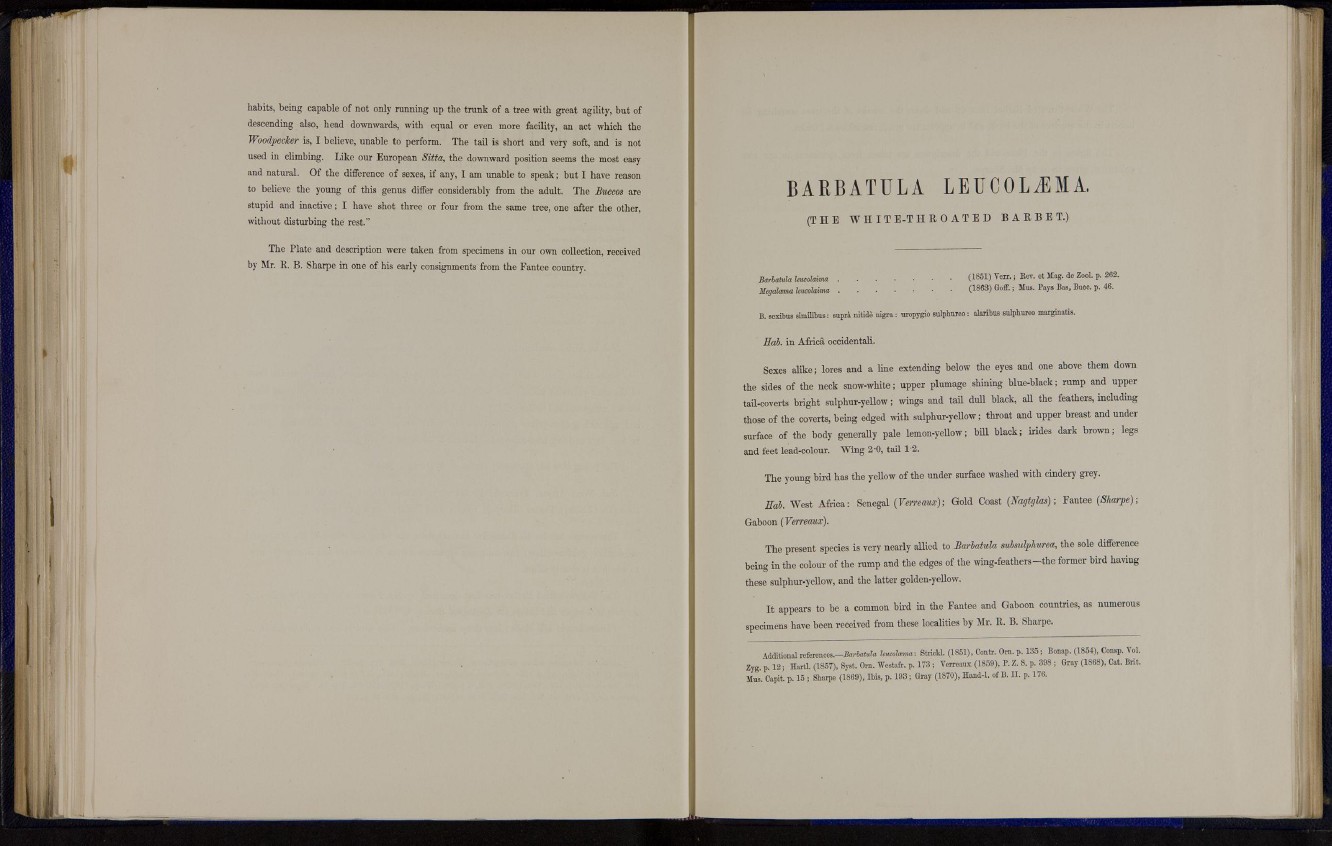
habits, being capable of not only running up the trunk of a tree with great agility, but of
descending also, head downwards, with equal or even more facility, an act which the
Woodpecker is, I believe, unable to perform. The tail is short and very soft, and is not
used in climbing. Like our European Sitta, the downward position seems the most easy
and natural. Of the difference of sexes, if any, 1 am unable to speak; but I have reason
to believe the young of this genus differ considerably from the adult. The Buccos are
stupid and inactive; I have shot three or four from the same tree, one after the other,
without disturbing the rest."
The Plate and description were taken from specimens in our own collection, received
by Mr. R. B. Sharpe in one of his early consignments from the Fantee country.
B A R B A T U L A LEUCOLiEMA.
( T H E W H I T E - T H R O A T E D B A R B E T .)
Barbatula leucolairm (1851) Verr.; Kev. et Mag. de Zeel. p. 262.
Megalac leucolaima (1863) Goff.; Mus. Pays Bas, Bucc. p. 46.
B. sexibus siroilibus: suprä nitide nigra : uropygio sulpbureo: alaribus sulphureo marginatis.
Hab. in Africä occidentali.
Sexes alike; lores and a line extending below the eyes and one above them down
the sides of the neck snow-white; upper plumage shining blue-black; rump and upper
tail-coverts bright sulphur-yellow; wings and tail dull black, all the feathers, including
those of the coverts, being edged with sulphur-yellow; throat and upper breast and under
surface of the body generally pale lemon-yellow; bill black; irides dark brown; legs
and feet lead-colour. Wing 2*0, tail 1*2.
The young bird has the yellow of the under surface washed with cindery grey.
Hab. West Africa: Senegal ( V e r r e a u x ) ; Gold Coast (Nagtglas); Fantee (Sharpe);
Gaboon (Verreaux).
The present species is very nearly allied to Barbatula subsulphurea, the sole difference
being in t h e colour of t h e rump and t h e edges of t h e wing-feathers—the former bird haviug
these sulphur-yellow, and the latter golden-yellow.
I t appears to be a common bud in the Fantee and Gaboon countries, as numerous
specimens have been received from these localities by Mr. R. B. Sharpe.
Additional references.—Barbatula leucolama: Strickl. (1851), Contr. Orn. p. 135; Bonap. (1854), Consp. Vol.
Zyg. p. 1 2 ; Hartl. (1857), Syst. Orn. Wcstafr. p. 173 ; Verreaux (1859), P. Z. S. p. 398 ; Gray (1868), Cat. Brit.
Mus. Capit. p. 1 5 ; Sharpe (1869), Ibis, p. 1 9 3 ; Gray (1870), Hand-1. of B. I I . p. 176.